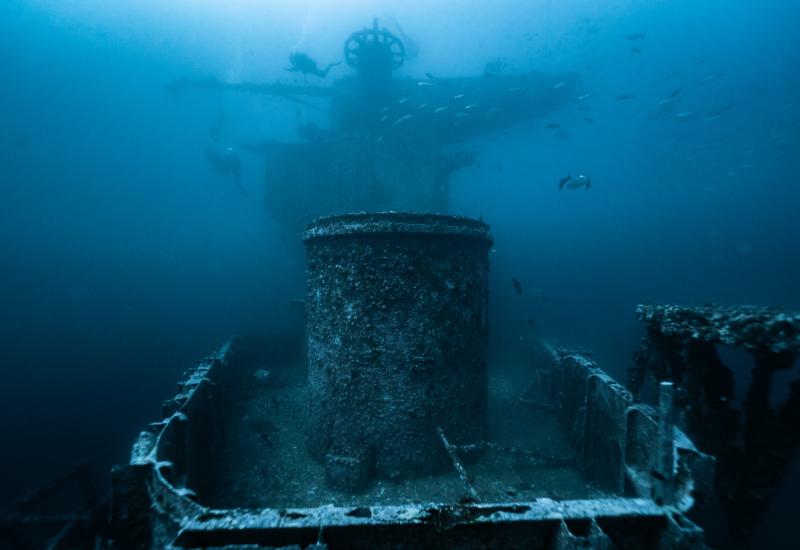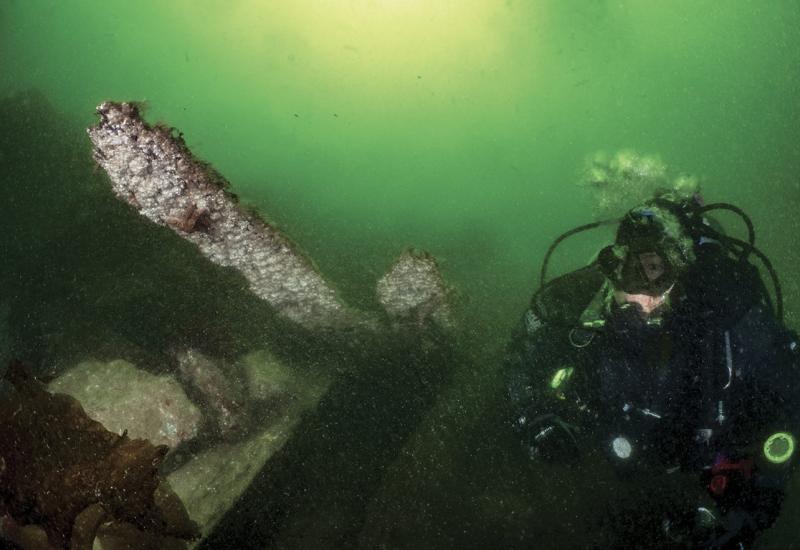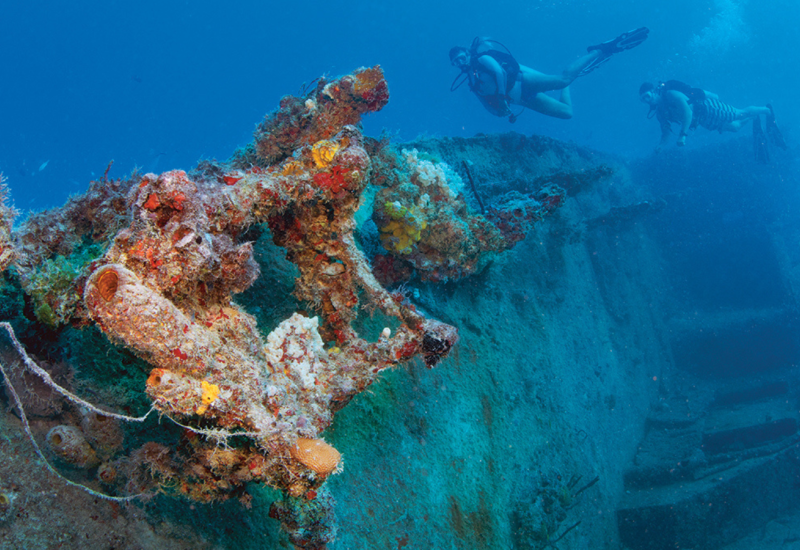History of Maui's Carthaginian Shipwreck
Learn how a replica whaleship and museum ended up as an artificial reef.

Yury VelikanauThe Carthaginian II sits in 97 feet of water off the coast of Maui.
Lahaina, Hawaii, on the island of Maui boasts a colorful history filled with kings and queens as well as missionaries and sailors. Once a bustling whaling port, the town now welcomes more tourists than whalemen to its harbor. Carthaginian was a replica whaleship — actually two replica whaleships, after the original ship was replaced by a second — and floating museum that bridged the town’s past and present. The ship still accepts visitors, but now requires those who wish to travel back in time to first travel below the waterline.
History of the Original Carthaginian
According to the Hawaii Historical Review, the Carthaginian was a three-masted schooner built in Denmark in 1921. It was originally called the Wandia and was 130 feet long with a beam of 22½ feet. Wandia hauled cargo across the Baltic Sea for approximately 30 years before being sold and brought to Central America. The new operator was not successful and sold the ship to American Tucker Thompson in 1964 and sent it to San Diego.
According to the R. Tucker Thompson Sail Training Trust, Thompson sent letters and photos to multiple film studios hoping to find work for his new ship. He was finally approached by the Mirisch Corporation in 1965 — the studio needed a whaling ship for its film adaptation of James Michener’s novel Hawaii, and Wandia’s size and hull were a close match to these kinds of ships. Tucker sold the ship to Mirisch under the condition that he would have first opportunity to buy the ship back upon the completion of the film.
The ship underwent a hasty transformation in San Pedro harbor, where it was turned into the Carthaginian, the square-rigged whaling bark in Michener’s novel. The process involved adding chase boats, a warrior figurehead, lookout hoops, equipment for removing blubber and other whaling tools to the ship. When the work was complete, Thompson assisted in sailing the ship to Hawaii and remained on hand to help handle the Carthaginian and Thetis, another ship used in the film, throughout production.
After the movie was finished in November 1965, Thompson repurchased the ship and took his family on a cruise around the Hawaiian Islands and the South Pacific. According to the Hawaii Historical Review, Thompson’s crew was made up of volunteers who were willing to share expenses in order to learn how to sail.
While anchored in Lahaina, Thompson was approached by the Lahaina Restoration Foundation, which wanted to purchase the ship and use it to showcase the town’s whaling heritage. Thompson agreed and returned the Carthaginian to Lahaina at the end of his voyage in mid-January 1967, where it would become a floating museum. Thompson relocated to Maui and worked for the foundation as the ship’s captain and curator until the summer of 1968.
The Carthaginian was anchored in front of the Pioneer Hotel and was filled with displays chronicling the lives of whalemen, including photographs of men in action, tools of the whaling trade and even the skeleton of a whale. Visitors were able to explore the ship’s cramped interior to see first-hand where the men would eat, sleep, work and amuse themselves during their long months at sea.
Carthaginian became a major source of income for the foundation. The ship was kept completely mobile and it was taken out periodically by a volunteer crew to keep all of its gear in operating shape and to make an annual trip to Honolulu, where it was dry-docked for maintenance.
According to the United States National Register of Historic Places, Carthaginian foundered on Lahaina reef on its way to Honolulu on Easter Sunday, April 22, 1973. The ship was destroyed, but there were no recorded casualties.

Okänd Fotograf/Sjöhistoriska MuseetKomet before it was transformed into the Carthaginian II.
Replica of a Replica
The foundation was quick to find a replacement for its lost museum and purchased a 93-foot German-made schooner called Komet for $21,000 the same year. The ship had been a cement carrier in the Baltic Sea, but — after being sailed from Denmark to Maui by an all-Lahaina crew — it would be transformed into a two-masted brig and rechristened Carthaginian II.
According to Kelii’s Kayak Tours, it took several years for the ship’s historically accurate rigging to be assembled. The ship’s 80-foot masts, deck, spars, yards and iron fittings were all hand crafted by the Lahaina Restoration Foundation. The steel-hulled ship was not designed to carry sails, so 15 tons of steel and cement were added as ballast to keep it from tipping over.
The new Carthaginian would spend the next 32 years entertaining guests and educating them on Lahaina’s past. But as the ship grew older the rusty steel hull became too costly to maintain. The Honolulu Advertiser reports that the Lahaina Restoration Foundation was spending $50,000 a year to keep the ship afloat during its later years. In 2003, marine engineers advised against further repairs due to increasing costs, and the foundation approached Atlantis Adventures, a submarine tour company, about turning Carthaginian II into an artificial reef.
Atlantis Adventures created the Hawaii’s first artificial reef off Waikiki in 1989 and has created a number of underwater habitats since then. Atlantis agreed to sink the ship and spent the next two years raising money for the project and preparing the ship for sinking. According to the Honolulu Advertiser, Atlantis spent approximately $350,000 on the project, which included environmental studies and making the vessel safe for marine life and scuba divers.
Carthaginian was towed away from its anchorage on December 13, 2005. According to the Honolulu Advertiser, the ship’s departure was marked by Lahaina Restoration Members placing leis on deck and holding up signs bidding it aloha as the Old Lahaina Lu’ua performed a rendition of “Aloha ‘Oe.”
The Lahaina landmark was towed approximately half a mile offshore of Puamana Beach Park, where a gathering of 20 boats waited. According to the Honolulu Advertiser spectators lined the coastal highway next to the park to watch the proceedings. After the ship was in position, patches were removed to uncover holes that had been cut into the hull and seawater was pumped in. Carthaginian II sank beneath the waves 27 minutes later to applause and three blasts from a miniature brass cannon.
Scuba Diving the Carthaginian II
Carthaginian II sits at a max depth of 97 feet on a sandy seabed. There is typically a slight current on the site, but the wreck is appropriate for scuba divers of beginner and intermediate skill levels. The masts have collapsed on deck, and divers can swim through the large, accessible hold. The engine room and forward compartment have been closed off, but scuba divers can still peer in through the bars.
Frogfish can be found all over the wreck, so keep a sharp eye out. Trumpet fish, sergeant major, orange spine unicornfish, rainbow cleaner wrasse and other small fish can be seen swimming about the ship. It is also possible to see turtles, sharks and eagle rays on this site.

Michael ZeiglerInside the shipwreck of the Carthaginian II in Hawaii.
Depth Maximum depth is 97 feet.
Visibility Viz is usually 100 feet or more.
Temperature Water temps in Maui range between 75 and 82 degrees Fahrenheit depending on the season.
Fun Fact Atlantic Adventures visits the wreck. If you hear a strange whirring noise, be prepared to wave at tourists aboard one of their submarines.
Dive Operators Lahaina Divers, Maui Dive Shop
Want more wrecks? Read about scuba diving the wrecks of Oahu.










